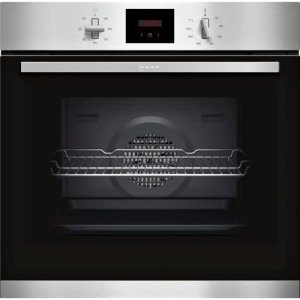
Best Built In Single Electric Oven
Add a review FollowOverview
-
Founded Date October 19, 1905
-
Sectors Roofing
-
Posted Jobs 0
-
Viewed 3
Company Description
10 Things We Do Not Like About Single Fan Oven
The Ultimate Guide to Single Fan Ovens
Single fan ovens, also called stove, have gained popularity in contemporary kitchens due to their capability to provide consistent cooking results. Unlike standard ovens, single fan ovens circulate hot air around the food, enabling even heat distribution. This article takes an in-depth appearance at the functions, advantages, and factors to consider related to single fan ovens.

What is a Single Fan Oven?
A single fan oven is designed with a fan and an exhaust system that disperse hot air evenly throughout the cooking cavity. This technology enables food to prepare more uniformly and typically decreases cooking times compared to standard ovens. The fan can be discovered at the back of the oven and works in combination with the heating elements, facilitating efficient heat transfer.
Key Features
| Function | Description |
|---|---|
| Even Cooking | Guarantees that food cooks equally and decreases the risk of hot or cold spots. |
| Time Efficiency | Decreases cooking time by as much as 20-25% compared to standard ovens. |
| Temperature Consistency | Maintains consistent temperature, causing trusted cooking outcomes. |
| Flexibility | Ideal for baking, roasting, and broiling throughout a variety of dishes. |
| Energy Efficiency | Typically takes in less energy due to shorter cooking times. |
Benefits of Single Fan Ovens
-
Uniform Cooking: The even circulation of heat ensures that all sides of the food are cooked all at once. This assists in attaining aspects like browned surface areas and damp centers, particularly in baked products.
-
Faster Cooking Times: The hot air blood circulation allows food to prepare quicker compared to traditional ovens. This effectiveness is particularly advantageous for hectic individuals or families with tight schedules.
-
Energy Savings: Thanks to their quicker cooking times, single fan ovens can often consume less energy, making them a more sustainable choice for environmentally conscious customers.
-
Multi-Shelf Cooking: Due to the even heat circulation, numerous dishes can be cooked concurrently on different racks without flavor transfer.
-
Decreased Need for Preheating: Many recipes can be executed without pre-heating, therefore saving extra time and energy.
Considerations When Choosing a Single Fan Oven
When selecting a single fan oven, numerous factors ought to be thought about to guarantee it meets your cooking requires:
-
Size: Choose an oven that fits conveniently in your kitchen area while supplying enough capacity for cooking or baking.
-
Functions: Many single fan ovens feature additional features such as self-cleaning choices, programmable settings, and several cooking modes (e.g., bake, roast, grill). Evaluate which functions are very important for your cooking style.
-
Energy Rating: Look for energy-efficient models that can assist decrease utility bills while likewise benefiting the environment.
-
Brand Reputation: Research various brands and their reviews to guarantee reliability and after-sales service.
-
Budget: Establish a spending plan that considers both the initial investment and long-lasting operating expense.
How to Use a Single Fan Oven Effectively
Using a single fan oven is fairly uncomplicated. However, to maximize its advantages, some ideas are important:
-
Adjust Temperatures: It is typically advised to reduce the dish temperature by approximately 20 degrees Celsius (or 25 degrees Fahrenheit) compared to standard ovens.
-
Usage Shallow Baking Trays: Shallow trays allow much better air blood circulation around the food, promoting even cooking.
-
Prevent Overcrowding: Leave area in between dishes to guarantee the hot air flows freely and cooks whatever evenly.
-
Turn Dishes: For even better results, consider turning baking trays midway through the cooking process, specifically with bigger or dense products.
Frequently Asked Questions About Single Fan Ovens
1. What types of foods can I cook in a single fan oven?
Single fan ovens are versatile and ideal for www.ovensandhobs.uk baking, roasting meats, cooking casseroles, and even dehydrating fruits. They can manage a wide range of meals across different cuisines.
2. Do I still need to pre-heat a single fan oven?
While many dishes can be cooked without preheating, some baked items, like soufflés or particular bread dishes, might carry out best when the oven is preheated.
3. Can I bake multiple trays of cookies at the same time in a single fan oven?
Yes, one of the advantages of a single fan oven is that you can bake several trays at the same time without compromising outcomes. Simply guarantee adequate area for air flow around each tray.
4. Is a single fan oven more energy-efficient than a traditional oven?
Yes, single fan ovens can be more energy-efficient due to faster cooking times, which minimizes total energy usage.
5. Are single fan ovens helpful for baking bread?
Single fan ovens are exceptional for baking bread as they provide even heat, which is crucial for attaining an excellent rise and crust.
In conclusion, single fan ovens offer many benefits in flexibility, efficiency, and cooking quality. Their capability to cook evenly and save time makes them an appealing option for home chefs. When choosing a single fan oven, think about elements such as size, functions, and energy consumption to discover the ideal suitable for your cooking needs. With appropriate use and care, a single fan oven can end up being an indispensable home appliance in any kitchen, boosting both preparing experiences and outcomes.
